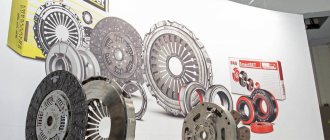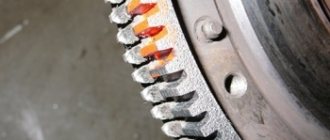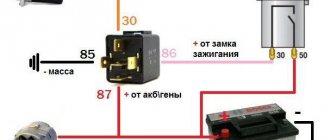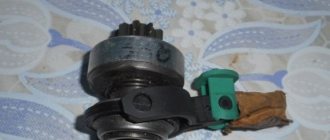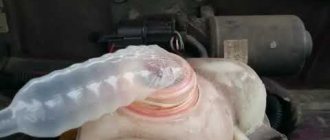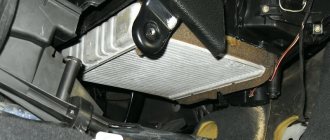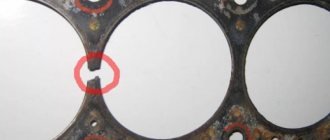Companies producing components for modern cars constantly have to solve conflicting problems. On the one hand, more power and dynamics are needed. On the other hand, we need to save fuel and reduce emissions. That is why the design must meet modern requirements. This is how dual-mass flywheels appeared. They are being installed on an increasing number of new modern cars. Despite their technology, they break. Let's find out how to check the dual mass flywheel, as well as the signs and causes of malfunctions.
Dual-mass flywheel repair
There can be many symptoms of a damaged damper flywheel, depending on what is damaged.
If you hear unusual noises when starting or stopping the engine, this may be a broken damper flywheel. This is especially noticeable at low engine speeds, and as the speed increases, extraneous vibrations and sounds disappear. Flywheel imbalance is accompanied by a loud humming noise that increases with engine speed. If vibrations are felt while accelerating the car, this indicates wear on the flywheel damper. Similar symptoms may occur with other breakdowns. How to check the damper flywheel? To do this, you need to carry out a simple test. In high gear, slow down to 1300-1500 rpm, and then press the gas pedal as far as possible to the extreme position. If you do not hear any strange sounds or vibrations, then your flywheel is most likely working normally. This test puts a lot of stress on the flywheel, so don't do it often.
But if you are sure that the damper flywheel is broken, then get ready for big expenses. True, some services offer disassembly and restoration of a dual-mass flywheel. But here you need to think carefully. Manufacturing plants do not provide for the repair of the damper flywheel, and therefore do not supply the necessary parts for sale. In order for the damper flywheel to serve for a long time, it is recommended: • Do not overload the vehicle; • Do not throw the clutch pedal; • Do not start driving from a higher gear; • Do not slip; • Do not drive aggressively.
What are the advantages and disadvantages?
In practice, the driver cares not so much about the technical performance and design features of the mechanism, but about the convenience and comfort of driving. Installing a dual-mass flywheel in a car gives the following advantages in practice:
- Gear shifting becomes more comfortable and smooth.
- The inertial moment during switching decreases.
- The resource of the internal combustion engine and gearbox increases.
- Space savings are achieved in the clutch housing, which is an important advantage for compact vehicles.
Despite its many advantages, it also has disadvantages. Firstly, the cost is quite high. Secondly, the service life is significantly lower than that of other types of clutch discs. This disadvantage is due to the design and internal lubrication, which is destroyed during operation. These are the only significant disadvantages that dual-mass flywheels have.
Despite the fact that the service life of the part is not unlimited, with proper driving the service life is estimated at 350-400 thousand kilometers.
Diagnostics
Experts tell you how to check a dual-mass flywheel. It is possible, even without removal, to identify that the spring is broken and to identify the presence of play. The diagnostic process is carried out during dismantling, without dismantling and during the repair of other components associated with the transmission. Preliminary tests are carried out directly on the car to check its behavior. The condition of the flywheel can be determined by measuring axial play, visual inspection, and measuring its angle of rotation.
Here is one of the known ways to check the Luk dual-mass flywheel and others. To do this, the car is put in high gear, the engine is revved up to one and a half thousand rpm, then the accelerator is pressed to the floor. If there are no extraneous noises, then the flywheel is in order. Otherwise, replacement is needed.
How to check the dual-mass flywheel on a Volkswagen? It needs to be removed and inspected. If characteristic color changes are observed, then the part has experienced overheating and overload. The driver held the clutch in slip mode for a long time. With prolonged overheating, the DMM may fail. Cracks may also form on the working part.
If there is yellowness below the working surface, this is a signal to replace the central bearing. It's worn out. You can also tell about wear by rumbling and whistling noises when moving. The flywheel is also replaced if lubricant leaks from its housing.
The essence of the problem.
Piston of an internal combustion engine: device, purpose, principle of operation
Even in steady-state engine operation, the rotation speed of the internal combustion engine shaft does not remain constant. Due to the design features of the engine (the process is periodic, regardless of the number of cylinders), changes occur even within one revolution.
The engine load (the moment of resistance transmitted through the transmission) does not change abruptly, allowing us to consider it as constant. The imposition of changing speed and torque of the power unit on a constant load leads to the appearance of the so-called. torsional vibrations of the crankshaft.
As a result:
- An increase in the strength and weight of engine parts is required (increasing mechanical loads require the creation of a safety margin);
- There is a danger of mechanical resonance, which can lead to crankshaft failure;
- Vibrations are transmitted to the clutch and gearbox, reducing the service life of the components;
- The level of comfort inside the car decreases.
The answer to the question of how to deal with engine vibration is an effective damper.
Certain conditions
By certain conditions we need to understand everything that causes resonant oscillations. Resonance can be characterized by the fact that when it is formed, the amplitude of vibrations increases. It is known from a school physics course that the resonance of a company of soldiers marching in step can destroy a strong bridge.
It is easy to imagine what could happen to the engine if similar processes begin to occur in it. If the impacts from the fuel combustion strokes, together with the kinematic forces, coincide with the frequency of the shaft oscillations, then the resonance will simply break the crankshaft as easily as breaking a match with your fingers. At the same time, to ensure satisfactory operation of the engine over a wide range of revolutions, a flywheel is needed.
Its task is to reduce the speed in idle mode and when the car starts moving. The greater the inertial moment of the element, the lower the speed. However, the flywheel is large and heavy, which increases the risk of resonance. Therefore, to eliminate these risks, engineers use torsional vibration dampers. The vibrations are converted into thermal energy.
Malfunctions and breakdowns
Engine crankshaft: its structure and purpose
The service life is now approximately 150 - 200,000 km. After this, the first signs of failure of this unit begin to appear:
- Creaking sound when starting or stopping the engine. It sounds like the starter is still spinning.
- Strong vibrations that have not been encountered before (for example, at idle) many confuse them with “triple” of the engine. Moreover, after the speed increases, the vibrations go away. The thing is that such flywheels operate on a two-stage principle; at idle speed some elements (the so-called soft ones) work, and at high speeds others (hard ones). This is why vibrations can occur at different speeds.
- Clicking noise when starting or accelerating
If you experience at least one of the listed points, then most likely it is either failing or has already failed.
What problems does this element have and can you identify them yourself?
Defects are mainly associated with the leakage of special lubricant, the appearance of scratches, dents or even creases and cracks on the surfaces. A mechanic at a service station will be able to diagnose all this without removing it from the car, for example, when replacing a clutch disc.
If there are no visible signs of malfunction (but sounds and vibration remain), the damper mechanism, springs may be broken, there are burrs inside, etc. It needs to be removed and diagnosed.
When removed, it can be checked on special stands, where its vibrations are read, and then a verdict is made.
Functions
Now let’s look at why this type of flywheel was needed. Experts know very well that in engine operating modes at the moment of each revolution, the angular velocity of the engine crankshaft is not constant due to the design features of piston engines. The angular velocity of the crankshaft changes periodically because the torque is uneven. The engine's operating process is periodic. The angular velocity is also affected by the kinematic characteristics of the crank mechanism.
The torque is uneven, and it is superimposed on the moment of resistance to rotation of the crankshaft. To compensate for this, the unit is designed in such a way that its nominal bending stress is within 20 percent, and torsional stress is about 15 percent of what the crankshaft itself can withstand. Why such strength, because these are extra dimensions and weight? However, the fact is that due to the irregularities that act on the shaft, its own torsional vibrations arise in it. Under certain conditions, they can disrupt the operation of the engine, and in rare cases, the engine can literally collapse.
To prevent this from happening, you need to know how to check the dual-mass flywheel on Frontera B and other cars. We will next look at diagnostic methods.
Diagnostics with special equipment
Purpose and design of the distributor breaker
Here's how to check a dual-mass flywheel using special tools. Using such devices, the maximum torsion angle is checked, as well as clearances - axial and radial.
Two- and three-stage flywheels have torsion angles from 60 to 75 degrees. The angle is measured up to 60 degrees. But even if the measurement showed 40 degrees, the unit can be used further. To measure parameters, a hole is found at the bottom. Then set the position, make a mark and rotate the flywheel to the right or left.
The gaps are measured at three points to ensure accurate readings. If the permissible limits are exceeded, the flywheel should be replaced. The axial gap should be no more than 0.2 millimeters. Radial clearance - no more than 0.15 millimeters.
Device
A dual-mass flywheel is equipped with two housings that move relative to each other. The housings are traditionally made of steel and fixed on one axis. Special damping elements and a bearing are installed inside one housing.
Knowledge of the device will help you understand the question of how to check a dual-mass flywheel. We will look at its malfunctions and ways to diagnose it.
Causes of clutch drive malfunction:
- Sticking, tearing or breaking of the mechanical drive cable
- Damage to the lever system
- Hydraulic system malfunctions
The flywheel is faulty if the engine periodically stalls and overheats. In addition, if torque is transmitted only at low speeds or vibration is felt in the cabin, then the key to the problem is also the flywheel.
The dual mass flywheel (ZMS) becomes faulty as a result of overheating, which can occur as a result of improper operation of the vehicle. For example, as a result of slipping, the mechanism overheats and the lubricant dries out, which is why the flywheel has to work with high friction. The consequence of this is jerking during gear changes. During a visual inspection, this problem can be identified by a change in the color of the metal or the appearance of cracks on it.
Sachs dual mass flywheel
The primary flywheel is worn out. This occurs due to gear overloads, which can cause internal parts to be destroyed and the ZMS to fail. If upon inspection you notice seeping lubricant, then this is the problem.
The internal parts of the secondary flywheel are worn out. The root cause of this is the failure of the release bearing located between the primary and secondary flywheel. There is a general heating of the mechanism, which reduces the effect of the lubricant and causes the parts to run dry.
ZMS has been blocked. If the flywheel is faulty, it means that too long mounting bolts were used during installation. This causes both the primary and secondary flywheels to lock, resulting in loss of shock absorption, grinding noise, and noise when pressed.
Clutch cylinder malfunction. This problem is not considered serious. The most common malfunctions are: fluid leakage and air ingress.
If air enters the connecting hoses and sealing collars, microcracks may appear. If this happens, don't panic. To eliminate this problem, you will need to bleed the system. Pumping does not require special skills or tools; it is familiar to almost all owners of their own vehicles.
Is it possible to independently determine whether the clutch master cylinder is faulty? Of course. To do this, you need to determine the location of the leak. To do this, brake fluid is usually added to the cylinder. A leak can be dangerous in the following ways: it will be impossible to break the connection between the wheels and the engine, which can cause an accident. The cause of the leak cannot always be determined during a routine inspection with adding brake fluid. If the problem lies directly in the cylinder, then it will be necessary to disassemble the mechanism. However, if the connecting pipes are leaking, then do not worry, because they can be easily replaced.
Such malfunctions can occur in cars with a mechanical cable clutch. Problems may be the following:
- The cable adjustment is broken
- There is a rupture or tear (biting) of the cable
The cable should be adjusted using a special nut, which allows you to adjust the cable mark. This procedure should be taken seriously, because incorrect adjustment can lead to either loosening of the cable or excessive tension.
The main reason for cable rupture is corrosion. As a result of the rupture, the clutch stops working.
Biting or, in other words, tearing of the cable is another reason why the clutch may stop working. If the metal threads of the cable begin to stop the movement, resting against the braid, then driving the car becomes much more difficult. The pedals may not be pressed well or may not return to their original position.
A little about the 2-mass flywheel
Nowadays, almost 80 percent of all new cars are equipped with a 2-mass flywheel. This unit is mostly used in cars with diesel engines, however, they are not uncommon in gasoline units.
A 2-mass flywheel may be designated DMF. Installed in tandem with a gearbox, single or double clutch. It is not uncommon in CVT systems.
It will be useful to know that DMF has been used since the mid-80s. last century, but they became popular 10 years later. However, at first, 2-mass balancers practically did not fail.
Subsequently the situation changed. 2-mass flywheels began to fail more and more often. The designers were able to identify the specific cause of this problem. It turns out that the engines of older cars had low power, which was the reason for the longevity of DMF.
Over time, engines have become much more efficient, and permissible ECO emission standards have been tightened around the world.
Modern 2-mass flywheels can withstand at most 150-200 thousand kilometers in such conditions. Any replacement of the transmission mechanism forces the repairman to also work with the DMF. These are additional financial costs.
When replacing the clutch, it turns out that the flywheel is so leaky that there is no objective possibility of holding out for the same amount of time as the new mechanism. They cannot work in tandem, so the owner has to decide to install a new 2-mass flywheel.
In monetary terms, replacing a DMF costs a Russian 20-50 thousand rubles. The final cost depends on the specific car model. Such monetary expenses occur in retaliation for the comfort and aggressive driving style, because in many cases it is the driver who is involved in the early operation of the element.
TOP 4 flywheel malfunctions
1. Wear of the ring gear. Knocks when turning on the starter and “slipping” will tell you about chips or the absence of several teeth. Installing a new component helps solve the problem.
2. Runout. If slight vibration appears at low speeds, the clutch mechanism has probably failed or the drive disc was not installed accurately during routine repairs. Aligning the part in the assembly with the clutch mechanism helps correct the situation. Unless, of course, the cause is natural wear and tear: in this case, you cannot do without replacing the component.
3. Wear of the adjacent surface. Risks and scuffing occur, as a rule, against the background of incorrect operation of the clutch mechanism. If the degree of wear is not critical, you can get rid of vibrations, slipping and noisy operation due to slipping of the driven disk by adjusting the unit. In other cases - only replacement.
4. Defects on the adjacent surface of the disk under the crankshaft. When using a car for a long time, they are inevitable, so there is only one way out: buy a new part.
The danger of the situation is that minor defects in the spare part do not disable the car: it still drives, although it is “outraged” about this by noise when the starter is turned on, uncharacteristic vibration and slipping. Sooner or later, the operation of such a component, which has exhausted its resource, will lead either to breakdowns in the transmission system or to rapid wear of the engine. Not to mention the limited power delivery and lack of torque will not escape the driver's attention.
Flywheel and reasons for its failure
The main cause of problems with the flywheel is improper operation of the machine. Driving with the clutch, difficult maneuvering, or accelerating in high gears leads to damage to the surface and teeth of the flywheel. Vibration, extraneous noise and slipping indicate a faulty part, which can lead to an emergency.
Flywheel as part of a car
A disk with characteristic teeth up to 40 cm in diameter is located on one side at the end of the engine crankshaft. The other side is fixed to the clutch basket. The flywheel performs the following functions:
Flywheel faults
Let's look at 4 main parts failures.
Small defects will not disable the car, but the fact that it is time to check the vehicle will be indicated by various manifestations that we discussed earlier. Operating a machine with parts that have exhausted their service life can lead to the breakdown of not just one part, but the entire mechanism and components. In almost all cases, the best option to eliminate a hazard on the road is to replace old parts with new ones.
Important! The car tells you when it’s time to get up for repairs and replace the flywheel: knocking noise at idle and when the engine is not warmed up, lubricant leakage, clicking noises when turning off the engine, vibration, extraneous noise in neutral, creaking when starting the car.
Self-treatment and flywheel replacement
Before installing the spare part, you must:
In practice, it is easier and more profitable to replace a flywheel than to restore it. Moreover, if you can replace it yourself, but you need to restore it using special equipment, which is usually done at the station.
Tips for Flywheel Life
Tip 1.
On a diesel engine, it is necessary to keep the speed in motion and not drive at low speeds.
Tip 2.
Refuse to tow a vehicle of the same weight category on a flexible hitch.
Tip 3.
Start the engine by depressing the clutch pedal; this also applies to turning off the engine.
Tip 4.
Pass technical inspection annually. inspection, where to pay attention to the starting characteristics of the battery, due to the direct effect on the rotation of the flywheel.
Thus, proper operation is the key to long-term driving without repairs. But if it turns out that there are signs of a malfunction, it’s worth taking care of the transport in the near future. Your life is more valuable than auto parts.
Flywheel design and purpose
Since the flywheel is a gear reduction element, it is a large driven gear. Since the flywheel is used in several vehicle systems, its design includes the following elements:
- flywheel ring teeth - necessary for transmitting rotation;
- internal seating surface - the part is attached to the internal combustion engine shaft;
- lateral surface - due to the tight fit of the clutch drive disc to it, rotation from the engine is transmitted to the gearbox.
Flywheel installation location
On the one hand, intense engine wear requires the use of parts made of carbon and alloy steels. On the other hand, the outer diameter of the crown exceeds 25 cm, which sharply increases the cost of the part. To increase maintainability and reduce the price of the flywheel, an assembly unit is used:
- cast iron disc with a large mass;
- a gear rim made of alloy or carbon steel, attached to its outer part with tension.
Flywheel design with crown
The main nuances of operating the flywheel are:
- the gear is used briefly at the moment the internal combustion engine starts;
- after which, the part transmits rotation from the crankshaft to the gearbox;
- pulls out their dead spots due to the inertia of the piston;
- smoothes out uneven angular speeds of the crankshaft, preventing engine wear.
During the factory production of a prefabricated flywheel, technologies are followed and high-tech equipment is used. After the working surfaces have worn out, the flywheel ring gear is usually replaced in the garage, so it is very difficult to ensure the service life declared by the manufacturer.
What is this
The first step is to understand what flywheels are in cars and their internal combustion engines. This is a part or component of the motor necessary to regulate the flow of energy. Gradually, the flywheel accumulates energy due to the fact that more energy is supplied than is necessary for the operation of the machine. At the same time, the flywheel releases the accumulated energy if the consumption parameters exceed the input parameters. It is necessary in the engine design for:
- starting the engine;
- connections between the internal combustion engine and the gearbox (transmission);
- transmitting torque from the engine to the gearbox;
- stabilization of crankshaft rotation.
If we talk about how the flywheel looks, then we can distinguish a structure similar to a metal disk. If you look closely at the edges, you will see a toothed crown. When a motorist turns the ignition key in the lock, the starter engages with the ring, turns it, and the flywheel begins to rotate the crankshaft, which allows the car to move. Although the flywheel is considered an integral element of the internal combustion engine, in practice it is closely connected with several systems at once. Namely:
- With gearbox of the starting system. This is where the rotation is transmitted;
- With starter. The flywheel sets the initial rotation of the motor shaft;
- With gearbox. The flywheel transmits torque here, receiving it from the clutch disc;
- With crank mechanism. Here the process of smoothing impulses occurs during uneven rotation.
The large dimensions of the structure allow the flywheel to gain sufficient inertia during initial rotations. Given the rigid connection with the crankshaft, the engine pistons do not linger when they are at the top and bottom dead centers. They follow further along the course of their rotation, creating new cycles of compression or ignition of the air-fuel mixture in the internal combustion engine. Since there are dead spots, the rotation of the shaft occurs unevenly, first the angular velocity is gained, and then it is lost. Taking this factor into account, the diameters of the flywheels for each engine are selected individually so that it is possible to effectively smooth out angular velocities depending on the period of time.
Location
Motorists rightly ask questions about where the flywheel is located in the engine structure, and how it is located in the power plant. To find this flywheel, you can look in your vehicle's owner's manual. The diagram will clearly show where the part is located on a specific motor. But even if the driver has not found the technical documentation, there should be no problems finding the element in practice. On all engines, the flywheel is located near the main bearing of the installed crankshaft. This is due to the fact that this particular bearing is the most powerful. Therefore, it will be able to withstand the load from the flywheel.
The flywheel is fixed to the crankshaft flange using a hub. In this case, its reverse side engages with the main coupling disc or clutch disc. That is, the arrangement can be characterized as installing a flywheel between the clutch basket and the crankshaft of the vehicle’s power plant. On the basket side, a strong fixation is carried out using a bolted connection. A ring gear is provided on the outer diameter of the flywheel. It is needed in order to engage the car starter's bendix at the moment when the engine starts.
There must be a special mark on the flywheel. It is designed to show the optimal position of the device relative to the clutch disc and crankshaft. That is, when dismantling or replacing, the flywheel is installed strictly according to the marks. Before installation on the car, each flywheel undergoes a balancing procedure on special stands. This is necessary in order to eliminate the possible occurrence of vibrations that can be transmitted to the crankshaft of an automobile internal combustion engine.
Recommended inspection times
All car owners whose cars are equipped with DMF are recommended to periodically diagnose the unit in services. The period is determined independently, depending on the availability of time (about 1-2 times a year).
If during operation of the vehicle clearly noticeable rattling or strong vibrations are detected, especially when the engine is idling, a visit to the service station cannot be postponed. This is definitely a faulty node that has two DMF disks.
It is important to understand that operating a car with a faulty DMF threatens to completely destroy the flywheel.
How to inspect the clutch basket?
How can you tell if the basket is worn out? It’s very simple: the first sign of wear on this part is slippage, which occurs if the disk is not pressed tightly against the flywheel.
Here are step-by-step instructions for checking the basket for wear:
Put the car on the handbrake. Start the engine and engage gear 3 or higher. Lower the right pedal and press the gas. Pay attention to the car's reaction to such actions.
What do these or other options indicate?
It is considered normal if the car stalls as a result of such impacts. This means that the clutch and gearbox are fine.
The following steps should be performed to determine a particular problem:
- Idle the engine.
- Press the right pedal all the way.
- Switch to first gear and move backwards.
If it is difficult to shift gears and strange sounds occur, it is concluded that the disk and flywheel are faulty.
The best time to repair and replace the clutch is the moment when the car is undergoing major repairs. If the power unit has already been removed, then repairing and changing the clutch will be much easier. If you follow the following plan of action, everyone will successfully cope with this job. Note that the described actions can be performed even in the garage.
So, the sequence is as follows:
- Remove the gearbox (gearbox). If there is no need to repair or replace it, you can safely disconnect the drive, battery and mass air flow sensor (mass air flow sensor). There is no need to drain the oil first.
- Unscrew the cable providing the transmission.
- Disconnect the starter.
- Loosen the fasteners on top of the box.
- Unscrew the elements of the speed sensor, as well as the electrical wiring harnesses.
- Slightly loosen the drive nut on the right, but unscrew it completely on the left.
- Unscrew the ball joint.
- Disconnect the engine protection.
- The torque rod must be unscrewed, and then the lower crankcase cover must be removed.
- Remove the linkage, first loosening the nut of the clamp, which helps control the gearbox.
- Unscrew the fasteners and bolts of the gearbox.
- Using a jack, lift the engine.
- Unscrew the box from the pillow and then remove it.
After the box is removed, the motorist can see the problem area and is able to perform some actions with it.
To replace the basket, you must first remove the retaining fasteners.
You need to pay attention to the petals: the basket should be replaced completely if it is significantly worn out
Before installing the new basket, you need to adjust the position of the gearbox input shaft so that the box can be easily put on in the future. Then a disc is installed in the flywheel.
After the position of the basket is corrected, it is necessary to tighten the bolts. This is done gradually: first 3-4 turns, and only then should it be fixed.
At the very end of the procedure, all that remains is to install the release bearing and shaft, which must be generously lubricated before installation.
All previously removed parts are installed back in the reverse order.
The clutch is adjusted by a special bolt with a lock nut, which is located at the end of the cable.
The pedal stroke is adjusted by turning the nut and should ultimately be 12-13cm. The increase or decrease in stroke is adjusted by screwing and unscrewing the nut from the tip.
To check whether the required distance at which the pedal is from the floor has been reached, it is recommended to press it several times and take a measurement. The adjustment continues until the desired distance is reached.
Hydraulic adjustment occurs differently. The distance between the pusher rod and the release fork should not exceed 5mm.
To adjust the distance, follow these steps:
- Remove the spring from the bracket and fork.
- Adjust the distance between the rod and the release fork so that it is 0.5 cm. This distance can be adjusted by screwing and unscrewing.
Note! Before adjusting the clutch, you must read the official instructions, since the methods described may not be suitable for certain car models
Why car malfunctions occur
Breakdown and wear occur if the car is not used correctly, the driver moves away with high acceleration, and the foot is constantly on the pedal while driving.
Basically, a car experiences breakdowns if its useful life has already expired. First of all, the driven disk wears out as a part with a limited service life. With proper use, this element lasts about 100 thousand kilometers. Those who like to drive change it after 30-40 thousand km.
However, the reason for the constant failure of the mechanism is the replacement with parts of poor quality. When purchasing, we recommend choosing originals.
Contamination of the friction lining of the disc occurs if oil gets on them as a result of wear or damage to the oil seals of the engine or automatic transmission.
You can easily diagnose problems visually, but one characteristic sign can diagnose several different problems at once. Therefore, the final reasons become clear when the entire mechanism is disassembled.
Malfunctions
To know and understand how to check the serviceability of a dual-mass flywheel, you need to learn about its possible malfunctions.
The DMM does not have any malfunctions as such - only its complete failure. In this case, the node is completely or partially destroyed.
Among the symptoms by which a breakdown can be identified are characteristic sounds during operation. For example, it could be squeaking or grinding noises when starting up. The second symptom that allows you to identify a malfunction is the engine tripping at low crankshaft speeds. At the same time, as the speed increases, the engine stops revving. Here's how to check the dual-mass flywheel without removing the box.
In addition to sounds, strong vibrations, knocking, and trembling will be felt. Sounds will occur when starting the engine, when stopping, and also when spinning the gearbox.
The dual-mass flywheel is the fruit of increased power
To dampen vibrations, the flywheel device now uses dozens of different springs located at some distance from the center. There are many more such elements than before. The leverage has increased, which means the efficiency has also increased. There are special separators between the springs, which are designed to dissipate vibrations, turning them into friction energy.
This device, despite its high efficiency, has a small working resource. Typically, with normal driving habits, repair of the dual-mass flywheel is required after approximately 150-350 thousand kilometers. To put it in normal language, this is definitely no less than the life of one clutch kit.
Diagnostics of double-disc flywheels
A complete diagnosis of a dual-mass flywheel, performed by someone who knows how to understand that a dual-disc flywheel is faulty and distinguishes between typical faults of dual-mass flywheels in modern cars with diesel or gasoline engines.
In particular, on diesel foreign cars, the springs of the damper flywheel often break, which can lead to an instant stop of the car and more serious consequences, since the elements get into the rotating parts and can even destroy the housing of the dual-mass flywheel.
What does the device consist of?
This is not a simple “piece of iron”; the structure here is much more complex. The structure of flywheels with two masses is different. As it becomes clear, here there are, as it were, two disks that are combined into one device (two masses). Each of the masses is attached to its source - one to the engine, the other to the gearbox. Moreover, these two disks can rotate freely from each other; they are connected only by a bearing
However, this way we won’t “move” the car; we need the torque to be transmitted from the power unit to the box and then to the wheels. That is, these two masses need to be somehow connected to each other. THIS is what the internal parts of the structure do, namely springs, flanges (they come in many types - asterisk, polygon, gear). The whole thing is closed with an airtight sealing cap. It is worth noting that the springs and internal cavity are often filled with lubricant
Let's look at a small diagram
This is one of the most common types, there are others, but they all have the same principle
News
Now we are ready to provide comprehensive supplies of synthetic, semi-synthetic and mineral oils for gasoline and diesel engines of passenger cars and trucks, transmission and industrial oils, lubricants and technical fluids for all types of passenger and commercial vehicles, both domestic and foreign.
Interturn spacers (autobuffers) are special spacers designed to increase spring stiffness. The part is not included in the basic package of the car and is identified by consumers as a tuning element.
Source
Problems with the electronic drive:
- The sensor has failed
- Electric motor malfunction
- The circuit is closed and breaks.
Diagnostics will be required if, when the clutch is gradually shifted, there are no alarming sounds, but when it is pressed in, noise and knocking are heard. The drive chain is probably broken if you have difficulty shifting gears.
Is the release bearing faulty or is it something else? We are talking about a bearing failure if the driver hears uncharacteristic sounds while squeezing the pedal
It is worth noting that a “squealing” sound means that the bearing needs to be replaced immediately. Otherwise, it may jam while driving
Most often, such breakdowns occur if the vehicle has a mileage of more than 100 km (on average 120-140).
The issue of checking the clutch on a car should be considered in more detail, taking into account some features.
When you press the pedal (both sharply and smoothly), the clutch slips
When this problem occurs, you should pay attention to the disks: they rotate at different angular speeds, being in a common circuit with the engine. The consequence of this: disc wear, as a result of severe overheating, the car accelerates more slowly
A similar situation occurs if the discs become dirty or worn out.
There was vibration in the cabin. The key to the problem is the flywheel. This part needs to be replaced. It may also be necessary to replace bushings and springs.
Extraneous noise is heard (crackling, buzzing, knocking, etc.). This may indicate a huge list of problems, from wear of the bearing (or bushings) to incorrect installation of the friction disc.
The pedal travel is disrupted, it is hard to press and returns to its original position. The problem is either in a leaking hydraulic system, or in an unadjusted, or adjusted but incorrectly mechanical connection.
Is the clutch burned out or not? The following signs will help you distinguish:
- A pungent burning smell appeared. If it appears in the cabin, then, definitely, the clutch has already burned out.
- The car starts hard. A situation is likely when the car does not move, even if you press the pedal to the floor. This happens because the disk has moved away and is not able to transmit torque to the engine.
- The car drives jerkily. This continues until the car picks up speed.
- Excessively free pedal movement.
Please note that only the primary signs of a burnt clutch are listed; a final conclusion can be given only after disassembling the mechanism (complete or partial).
Symptoms and causes of malfunction
Let's take a closer look at the symptoms of failure of this type of flywheel and signs of malfunction:
- the appearance of uncharacteristic sounds is the first symptom that it is recommended to pay attention to (this could be a squeaking sound when starting the engine or a grinding sound);
- the second symptom, which in 90 cases out of 100 makes it possible to determine a flywheel malfunction, implies tripping of the internal combustion engine at low speeds (while the tripping disappears as soon as the speed increases).
The sounds from a faulty flywheel are always different in nature. As was written above, failures in the DMF are the source and cause of severe vibrations and tremors felt in the car’s interior. Foreign sounds and vibrations occur when starting the internal combustion engine, stopping the car and, of course, when the gearbox moves from low to high speeds.
DMF failure is due to several reasons: the formation of scratches or cracks on the surface, lubricant leakage, or destruction of springs.
The number 1 reason for wear of the 2-mass flywheel is considered to be the large CM of modern engines. The relatively high pressure prevailing in the fuel system introduces its own negative aspects. In addition, modern engines are assembled from light alloys, which suppress vibrations less well.
Specialists know very well how to check a 2-mass flywheel, whether its spring is broken, whether there is play or something else. Craftsmen take into account a number of little things before removing a 2-mass flywheel, fully understanding the complexity and time costs of the event.
As a matter of fact, flywheel diagnostics can be carried out in three known cases: when dismantling the element, without dismantling it, and during repair work with other components (specifically the transmission).
You should know that DMF preliminary testing is based primarily on a description of the machine's behavior.
The condition of the 2-mass flywheel can be diagnosed by measuring the endplay, by visual inspection, or by measuring the rotation angle.
There is also one known way to check:
- The car's gearbox is set to a high gear while driving;
- the engine speed is brought to 1300-1500 rpm, the speed slows down;
- the accelerator pedal is pressed to the floor.
This test diagnoses the behavior of the machine. If no extraneous noise appears, then in most cases the DMF is fine.
Basic faults
There are several types of malfunctions that arise during the operation of this engine element.
Defect one: wear and/or damage to the element’s ring gear
Causes of malfunction:
- wear and/or breakdown of the starter, its individual elements or components;
- incorrect installation of the starter in the flywheel housing;
- foreign particles entering a device such as a flywheel housing;
- errors during the assembly of the structure;
- The flywheel ring gear is worn out during long-term engine operation.
Progress:
- The flywheel ring gear must be replaced;
- correct installation of the starter in the flywheel housing;
- checking the operation of the starter and repairing it, if necessary.
Defect two: flywheel runout
Causes of malfunction:
- clutch wear or failure;
- clutch slip;
- natural wear of the component during long-term engine operation;
- assembly errors.
Progress:
- runout check;
- with low runout - surface treatment using a lathe;
- with large runout - change the part;
- checking the functionality of the clutch, repairing it and replacing it if necessary;
- checking the operation of the clutch release drive and repairing it, if necessary;
- proper tightening of the mounting bolts, while maintaining the correct torque - approximately 100 N*m.
It is worth noting that the permissible runout value must be set by the manufacturer; it can be found in the corresponding reference book. In this case, you need to know what role exceeding this value can play.
In this case, the car owner may notice some signs of malfunction when the engine is running. When correcting malfunctions, it is necessary to observe the correct tightening torque of the mounting bolts.
Defect three: violation of the functionality of the working surface under the clutch driven disc
Causes of malfunction:
- clutch wear or failure;
- clutch slip;
- the device wears out during long-term operation of the engine;
- errors when assembling the part.
Progress:
- element replacement;
- checking, repairing and replacing the clutch if necessary;
- checking and repairing the clutch release drive as necessary.
These signs can be detected during diagnosis.
Defect four: damage to the crankshaft flange seat
Causes of malfunction
- the device wears out with prolonged engine operation;
- violation of the assembly of the part.
Progress:
- part replacement;
- checking, repairing and replacing the crankshaft as needed;
- correct installation of the crankshaft in the flywheel housing;
- correct assembly technology;
- implementation of the correct tightening of the bolts securing the element to the crankshaft, while maintaining the correct torque.
When carrying out troubleshooting work, the correct tightening torque of the mounting bolts must be observed.
How it works?
To increase the angle of elastic torsion of the two flywheel housings relative to each other, the springs in the DMM have several degrees of compression. The spring blocks are divided into outer and central blocks by means of separators. The outer block is more rigid. During engine operation in different modes, the flywheel masses can shift by any angle relative to each other. In this case, the central block with springs is compressed, thereby compensating for the increased angle of rotation of the masses. This is the engine operating mode during a quick start or during engine braking. Modern flywheels can have two or even three compression levels. This way the transmission is reliably protected from maximum loads.
Comments from car owners about replacing the flywheel
- Replacing a dual-mass flywheel with a single-mass one: reality or wasted money (and at the same time, the car)?
Here they ask: is it possible to change the damper flywheel to a single-mass one? Yes, there are craftsmen who make such a replacement.The problem with such a “modernization” is related to the fact that a manual car with a powerful engine will start moving with vibrations. Over time you will get very tired of it.
The situation will be completely different with a car that has a robotic gearbox. A regular flywheel will ruin such a transmission, and repairing the robot will cost 10 times more than buying a new dual-mass flywheel. So do the math and draw your own conclusions.
- Flywheel restoration is a gamble
A flywheel that has exhausted its service life must be replaced with a new one that has the same design. What to do if there are not enough funds for such repairs? In this situation, restoration will help. There are companies that provide such a service for any car model. The advertisements of such companies say that after repair the flywheel will work no worse than a new one. Theoretically this is possible.For example, the owner of a Volkswagen, which is quite expensive to repair, decided to restore the damper flywheel and replace it himself. This owner still has one spring left on his “original” flywheel. The company that restores flywheels made the rest of the springs based on the model and restored the part. Fortunately, everything ended well for this car owner. He was able to save a significant amount, since a new flywheel costs about $1,350.
- Is the dual mass flywheel damaged? You have two options
Some experts believe that the short service life of the dual-mass flywheel (200,000-350,000 km) is due to improper operation of the car. To reduce fuel consumption, drivers drive diesel cars with powerful engines at very low speeds. In such a situation, high torsional vibrations of the crankshaft create a high load on the flywheel springs and shorten the life of this part. In addition, experts advise that to increase the service life of the damper flywheel, turn off the engine with the clutch pedal depressed.What to do if the dual-mass flywheel fails?
If the dual-mass flywheel of your car has reached the end of its life, do not rush to look for a large sum of money for repairs. There are two ways to solve your problem while minimizing losses. The first option involves replacing the damper flywheel with a conventional single-mass part from the well-known Valeo brand. This manufacturer has developed single-mass analogues of Luk and Sachs flywheels, since there is no such alternative in the lines of these brands (and who wants to lose big profits).
The second method involves restoration of the damper flywheel. Over time, this direction is developing more and more. Specialists can completely overhaul and restore the flywheel. Restoration will cost much less than buying a new part, and driving the car will be more comfortable, compared to the option when an analogue from Valeo is installed.
- Dual mass flywheel = single mass flywheel + clutch kit
For Ford cars with 1.8TDCi engines, there is an excellent option to avoid problems with dual-mass flywheels. You can install a clutch kit with a conventional flywheel from Ford Torneo Connect (Valeo). To do this, in addition to the flywheel/clutch pair, you will also have to change the starter, because the teeth will not match.The cost of such an upgrade will still be less than replacing the original clutch kit and damper flywheel. After this, you will no longer have to change the flywheel, but only the clutch, which will allow you to significantly save on repairs.
This upgrade also has its downsides. During active driving, the clutch will begin to “slip” (however, the Connect has a less powerful motor).
- Dual-mass flywheel from disassembly: cannot be thrown away
Malfunctions of the dual-mass flywheel are associated with stretching of the springs (stage 1 of failure) or their destruction (last stage). When the springs stretch, the flywheel will play and cause imbalance. This situation will be complemented by vibrations and knocks. If the springs burst, then the consequences will be generally sad.As long as the springs are intact, even when stretched, they will be able to perform their function of smoothing out forces.
The dual-mass flywheel can be compared to a used condom. I already have one of these lying around in my garage. For some, it will still pass as a “used one in excellent condition”, but I replaced it, since the ride comfort was not at all the same.
Fasthut › Blog › Assessing the condition and replacing the LUK dual-mass flywheel
Let me remind you, just in case, that it was LUK that developed and introduced dual-mass flywheels into mass production
Sachs joined later, but Valeo, although it offers them, is far behind :-). However, only LUK has the special tools and technology to assess the condition of a dual-mass flywheel
For what? The design of the flywheel itself implies a displacement of one part relative to the other, with free play and play in two planes. Even a completely new flywheel may seem excessively loose to an inexperienced user :-) What if the box was removed in search of extraneous sounds, and the flywheel is the main suspect? It's easy to change. But it's expensive. Therefore, the ability to evaluate the condition “in grams”, IMHO, is a very nice bonus from the manufacturers. On their technical portal REPEXPERT, they kindly posted training videos and the necessary technical information, in particular on tolerances:
How to deal with engine vibration
The power and speed of cars are growing in proportion to the public's needs for comfort. And increasing engine power is associated with a lot of problems that do not always coexist peacefully with comfort and other requirements for modern technology. This includes increased fuel consumption, uneven engine operation, increased noise and vibration. If for a sports car all these conventions can be written off, then a comfortable business-class car must fully meet the requirements for comfort.
Vibrations have always bothered designers and there is no escape from vibrations. It is possible to calm a vibrating part or shaft only by creating an anti-load, a counterweight. And this, naturally, increases the mass of the mechanism. For example, you can look at wheel balancing at a tire shop. If you do not hang a load of a certain weight on the wheel in a certain place, vibration cannot be avoided. But we will increase the sprung mass, which is harmful to the condition of the chassis. Almost the same story is observed with the crankshaft of a car. To avoid unnecessary vibrations, a special balancer or flywheel is used.
